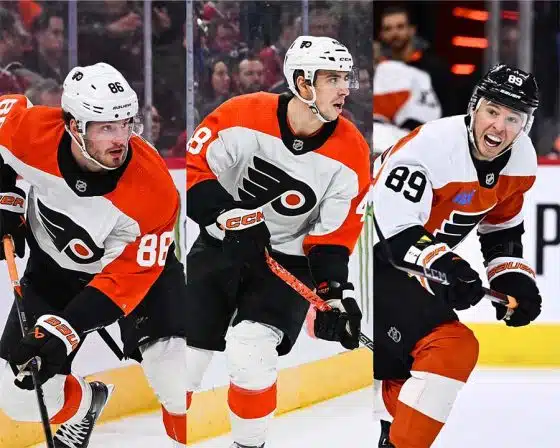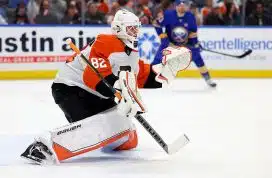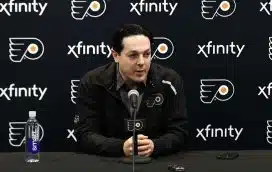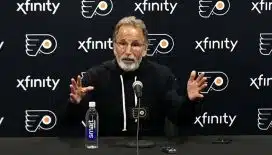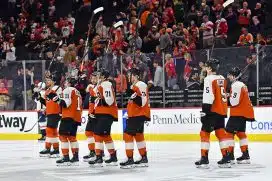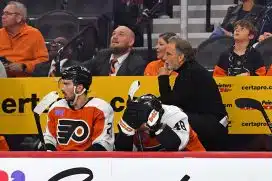Philadelphia Flyers fans may be excited about the future, but how will the injection of young players impact Claude Giroux's future role with the team?
By Dan Heaning, Sports Talk Philly staff writer
With the annual Flyers Development Camp concluding last week, fans were able to catch a glimpse of the franchise's future.
Yet, when focusing ahead to potential better days, one thing that is overlooked is what the consequences the injection of youth will have on the current roster. Prospects like Nolan Patrick, German Rubtsov and Oskar Lindblom are on the horizon to make the team within the next season or so.
Their rise to the NHL level will make many current Flyers' futures with the organization murky. One of the more intriguing fates to contemplate is that of current captain Claude Giroux.
It briefly seemed his future in Orange and Black was coming to an unexpected end as Giroux was the subject of trade speculation during the NHL Entry Draft. However, those rumors passed like so many others do: with the player remaining with his current squad.
Still, given his regression coupled with his salary cap hit of over $8 million until 2022 and Father Time’s looming hand, Giroux’s long-term future with the organization will soon become a question if it hasn't already.
Some fans choose to stick their heads in the sand concerning Giroux’s waning numbers, growing age and lofty cap hit. Meanwhile, others believe in the asinine notion of stripping the captaincy or trading him now while his value is high.
Related: Jeremy Roenick to Claude Giroux: 'Start Attacking the Game'
There’s no benefit to removing the letter from the player who has served the most games as captain since Dave Poulin and is 22 contests away from trailing only Bobby Clarke in that distinction. Such a gesture would likely only be a detriment to the team. In fact, Giroux should bear the captaincy until he chooses to no longer be a Flyer or is dealt.
Speaking of which, those trade talks are based on the concern that Giroux could become an $8.275 million weight on the team as he enters his 30's. To put it simply, he will not become a burden for his teammates to overcome. While his numbers and skills may diminish, his most valuable trait to the Philadelphia Flyers is and will continue to be his leadership.
When the Flyers core shifts to Patrick, Lindblom, Rubtsov, Travis Konecny, Ivan Provorov, Shayne Gostisbehere, Travis Sanheim and whoever else stakes their claim into the extended future of the Flyers, they’ll need an on-ice presence who can tamper, teach and impart by example.
With the exception of Valtteri Filppula, who is likely not going to be a part of the team's plans beyond this upcoming season, Giroux is the only player on the Flyers roster who has played in a Stanley Cup Final game. He’s also the only player on the team that has scored a game-winning goal in a Stanley Cup Final overtime.
That distinction will be very important if and when the new core makes its postseason push. Veteran leadership is a cornerstone for any Stanley Cup champion whether it was Marian Hossa joining Chicago with a young Jonathan Toews and Patrick Kane duo or Pittsburgh enlisting Bill Guerin to show Sidney Crosby and Evgeni Malkin the ropes.
Young teams looking to earn postseason success need veteran leaders who can calm them when they get worked up, pick up their spirits when things go wrong and keep them level-headed when things go right.
This is Giroux’s intrinsic value to the Flyers going forward. He's been through the bumps and bruises of a seven-game series. He's the lone player left from the 2010 team that came back from being down 3-0 in a series against the Boston Bruins. When the pressure of the Stanley Cup playoffs seems too much for any of those young players, Giroux will be the one who keeps things together. He'll be the one that Patrick, Konecny and Lindblom will look to for guidance.
A great example of the type of player and captain Giroux could be for the Flyers going forward would be 2017 Hockey Hall of Fame inductee Dave Andreychuk.
On the surface, comparing Giroux and Andreychuk is something that can be easily picked apart. Andreychuk was a 6'4", burly power forward. Giroux is a 5'11", crafty playmaker. Their games are hardly similar. However, the basis of comparison is not against each other. Instead, it is what one did and what the other can provide for a young team.
Some younger fans may not realize that Andreychuk was a proficient goal scorer in his prime. Andreychuk scored 40 or more goals in four campaigns and produced multiple 80 and 90-point seasons.
Yet, after Andreychuk turned 31, his production began to decline. After producing 99 points at the age of 30, his production dropped to the 60's, 50's and eventually the 30's over the course of his career. Despite this regression, his game suited the clutch-and-grab style at the time. Therefore, he was able to transition from a high scoring power forward into a bottom-six supporting role player.
In four seasons, Andreychuk went from producing 99 points to a Selke Trophy-caliber winger who could still pot 20 goals. Even in his late 30's and early 40's, Andreychuk was considered for the All-Star team and the Selke Trophy, though, he was nowhere near winning it.
The trade-off to Andreychuk’s reduced on-ice role was that he would take on the captaincy in Tampa Bay. The Lightning were in desperate need for a mature voice in the locker room, a veteran leader to guide young players like Vincent Lecavalier, Brad Richards and — a slightly older — Marty St. Louis, who were entering their respective primes. Despite his decline, Andreychuk played for nine more years while Father Time gradually claimed his game. During that timeframe, he captured his only Stanley Cup championship at the age of 40.
Andreychuk played in 139 playoff games before his last playoff run. Giroux has nearly hit half of that before reaching 30. Giroux has already played in 63 playoff games, a total nearly identical to Andreychuk’s amount (62, most of which came in a 21-game run with Toronto) before reaching his 30's.
While the clutching and grabbing era served Andreychuk well in his longevity, Giroux’s skill set should make him valuable in the future NHL.
The way the game is played now, speed, two-way play and playmaking are the emphases. Giroux is already a solid two-way center as he’s received votes for the Selke Trophy in each of the last two seasons. His playmaking ability is still evident, especially on the man-advantage, and his skating remains strong. While age will naturally claim his speed, as long his core attributes remain, Giroux's value shouldn't dip beyond a top-six or top-nine role.
His longevity can also be aided by receiving reduced ice time. This was something general manager Ron Hextall tried fruitlessly this past season by signing Boyd Gordon as to lessen Giroux's penalty killing minutes.
Going forward, gradually reducing Giroux’s ice time in favor of Patrick, Konecny, Lindblom and Rubtsov will help two-fold. For starters, Giroux would no longer be facing top-pairing defensemen and, therefore, will likely see more scoring opportunities as he's pitted against second or third-pairing blueliners. Secondly, the reduction in minutes would lessen the physical toll on his body. Fewer hits, fewer blocked shots, fewer slashes and hooks would only help Giroux extend his career.
Though, with those youthful additions and their eventual increased roles comes the reality that Giroux could have to return to wing as well. Playing center may require younger and faster players than what Giroux may become in his 30's. It would be a natural move as he was drafted as a winger and initially played on the right side during his first few seasons.
As it stands now, Giroux is the Flyers best player in the faceoff circle. However, within the next few seasons, the potentiality of Patrick, Rubtsov, Sean Couturier and Mikhail Vorobyev becoming more suitable centermen as the game becomes faster and the lineup is filled out by more and more young players is a real possibility.
Switching to wing would reduce Giroux's coverage areas which would make each shift less arduous than the ones he plays now as a center. On the other hand, the maneuver could put him in a position to take more hits along the boards, but since he would be in possession of the puck less frequently as a winger, it should decrease the odds of him absorbing a cataclysmic open ice collision. It'll be impossible for Giroux to avoid contact, but a reduction in ice time coupled with less physically taxing shifts should aid in prolonging his career.
That move is probably a little further down the road as it is also a possibility that Giroux’s presence pushes one of the young bucks to wing. This is especially true for any one of the prospects’ first few seasons as they adjust to the professional hockey level. However, as they adjust, develop and reach their primes, their play may propel a role reversal.
Even though they may force Giroux into a different role, all these prospects can also provide Giroux’s offensive numbers a shot in the arm similar to how a young Alexander Mogilny aided in Andreychuk having some of his most productive seasons of his storied career. Instead of playing alongside the likes of Brayden Schenn, Michael Raffl, Scott Hartnell and Matt Read, Giroux could be paired with younger, faster and perhaps more talented players, who are entering their primes rather than departing from it, to find with his playmaking skills.
Just because the future is quickly approaching doesn’t mean the Flyers have a Claude Giroux problem. There's no need to panic and demand his captaincy be stripped or call for him to be dealt. Instead, it could be that the cavalry will make it just in time to give Giroux’s career a second wind and he should remain in Philadelphia to lead the cavalry up the hill.
Podcast
Subscribe to the Flyerdelphia Podcast on iTunes, Google Play and YouTube.

